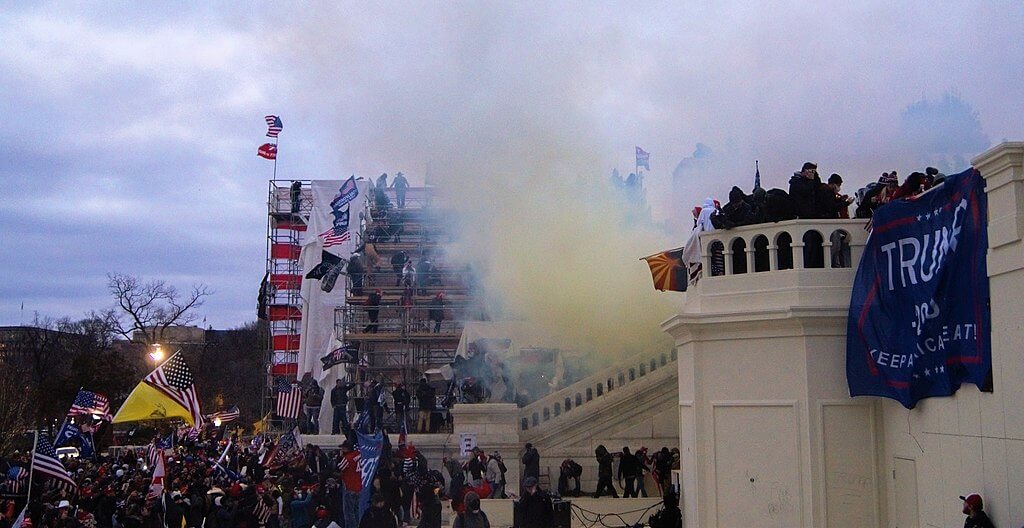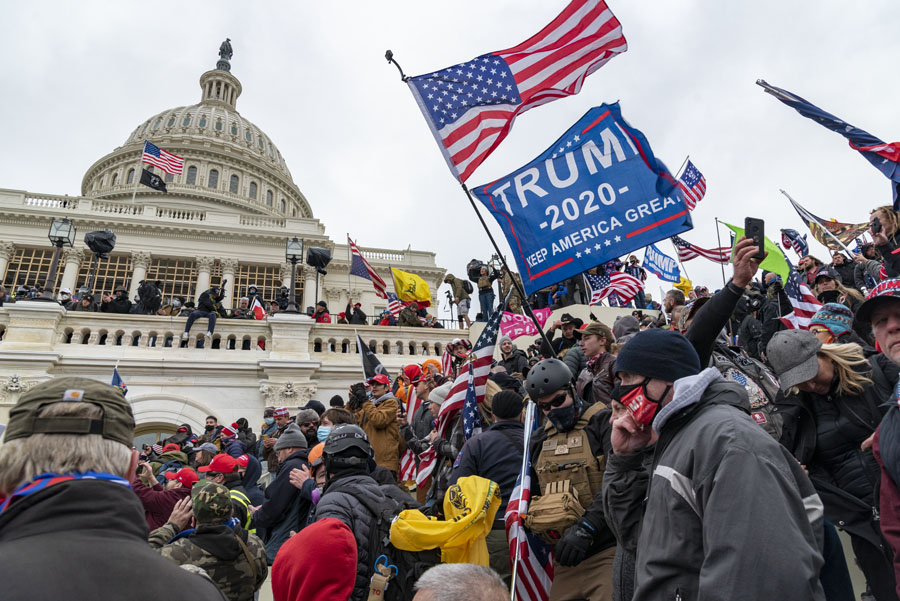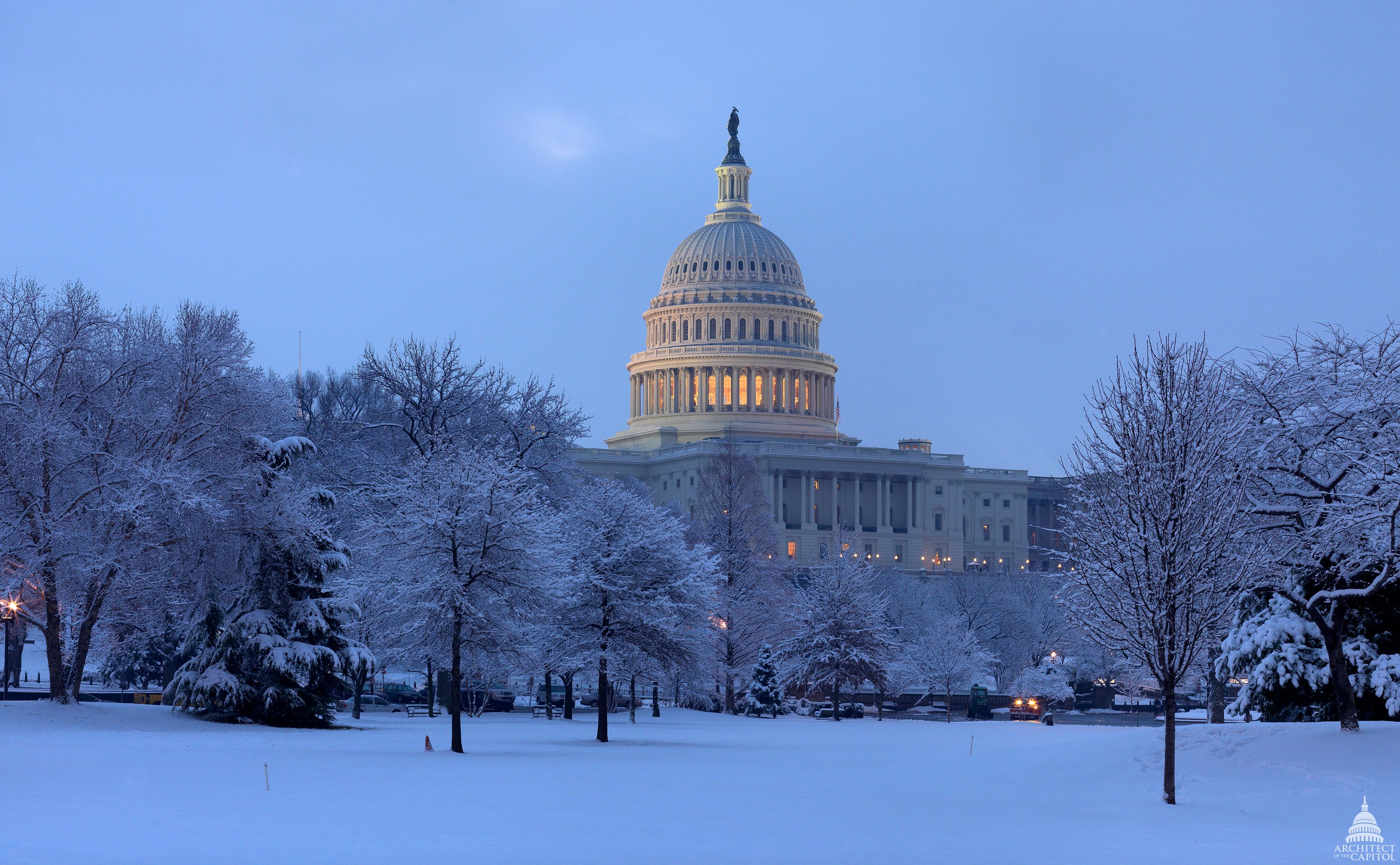The Long Descent to Insurrection
A former select committee investigative counsel explains how the extremist coalition that came together on Jan. 6 began developing in the chaotic early months of 2020, long before Trump called on them to come to the Capitol.

Published by The Lawfare Institute
in Cooperation With

Editor's note: listen to a conversation with the author and Lawfare Senior Editor Quinta Jurecic on the Lawfare Podcast here.
The release of the final reportof the Select Committee to Investigate the January 6th Attack on the United States Capitol was the culmination of a yearslong sprint to uncover the facts behind the attempted insurrection. The committee’s top-line conclusion has been well established by now: Donald Trump’s authoritarian obsession with retaining power resulted in a multipronged assault on American democracy that reached its bloody climax on the steps of the Capitol. By exposing that truth, the committee accomplished its most urgent task, which was to warn the public about the dangers of Trump and his coup-enthusiast lackeys.
But that story is only one piece of a broader constellationof evidence assembledby the committee, including an unprecedented inside look at the coalition of domestic violent extremists who answered Trump’s call to upend the rule of law. I was part of a small team of investigative counsels who were responsible for interviewing members of the Proud Boys, Oath Keepers, and other individuals associated with far-right extremist groups. This evidence we collected should be a warning to the general public that the Jan. 6 assault is part of a broader threat of paramilitary violence and its intersection with electoral politics, which began long before the day of the insurrection and has endured far after it was quelled, as former Acting Assistant Attorney General for National Security Mary McCord and I wrotein Just Security.
However, this evidence can also be studied in order to reshape public perceptions of the underlying dynamics that made the Jan. 6 attack possible in the first place. The committee’s report and investigation rightly focused on the immediate lead-up to Jan. 6, particularly by zeroing in on the importance of Trump’s tweetfrom Dec. 19, 2020, as a rallying call for extremists to come to D.C. But the larger universe of evidence released by the select committee shows that there was a much longer run-up to the attack that stretches back to at least the beginning of 2020, if not earlier in Trump’s term.
Depositions with Proud Boys, Oath Keepers, QAnon adherents, and others revealed how extremist mobilization did not begin with Trump’s call to his supporters to come to D.C. or even with his refusal to concede the election. The committee uncovered a monthslong trend toward political violence by these groups spurred on by pandemic-related health restrictions and, later, Black Lives Matter protests. Our evidence shows that the violent energy that burst forth on Jan. 6 had been cultivated during the tumultuous months prior, including in the most fascistic fantasies of Oath Keepers’ leader Stewart Rhodes and chief Proud Boy Enrique Tarrio.
In many instances, the right-wing extremists we deposed pointed to a clear throughline between the perceivedtyrannyof Democratic politicians’ imposition of coronavirus safety measures in the spring of 2020, the alleged “riots” that occurred in left-leaning areas during the summer, and those same cities allegedly manufacturing ballotsand enabling shadowy forcesto steal victory from President Trump in the autumn. Beyond revealing the racist heart of the “Big Lie,” this narrative arc shows why paramilitary groups like the Proud Boys, Oath Keepers, Three Percenters, and others were so ready and willing to answer Trump’s command to “stop the steal.” To them, it was the natural extension of what they had been preparing for all year long—often at Trump’s urging—as they grappled with what they saw as an extended crisis that required a vigilante response.
The Trigger of the Coronavirus
As our team conducted depositions with assorted far-right extremists, I was at first surprised by how consistently the onset of the pandemic was cited as the genesis of their engagement with domestic violent extremism. But as we conducted more and more interviews, it began to make sense that the society-altering fallout of the coronavirus would have also had a strong impact on the evolution of the Jan. 6 coalition, because it provided an unprecedented opportunity for paramilitary extremists to join forces with others on the far right in a joint effort to target the government, which would lay the groundworkfor the type of coalition that was eventually mustered on Jan. 6.
Perhaps the most consequential example of this phenomenon was Kellye SoRelle, lawyer for the Oath Keepers and close confidante of Stewart Rhodes as he plotted his seditious conspiracy. SoRelle said her desire to fight back against the coronavirus public health measures initially led her to engage with the Oath Keepers. She testified that a “ragtag” association of groups had private militias—including Rhodes and the Oath Keepers—that acted as security for anti-lockdown activists who challengedrestrictions in Texas.
In context of these anti-lockdown protests, SoRelle described the Oath Keepers’ mission as one of “taking care of your community” and said that they were “just providing support for those of us that were trying to exercise our First Amendment.” Similarly, in his deposition, failed Michigan gubernatorial candidateand Jan. 6 defendantRyan Kelley spoketo the committee about his decision to found the far-right paramilitary American Patriot Counciland said that it was prompted by “the response of everything with the COVID-19 pandemic and the lockdowns and the rules and regulations.” Kelley went on to testify that he wanted to “inspire fellow individuals in Michigan or across America to stand up for our rights, stand up for what’s right.” QAnon boosterJim Watkins testifiedthat coronavirus restrictions were “used as an excuse to take over the country” and cited them as a reason why his website, 8kun, was needed to keep the country free. This argument was echoed by witness after witness as they justified their paths to insurrection.
The early months of the pandemic also had an organizational impact on the Jan. 6 coalition. North Carolina militia leader Michael Lee Wells sharedhow the Three Percenters started “intel sharing” chats with other militia groups when the state imposed lockdown measures (although he denied this led to further communication). SoRelle similarly describedthe anti-lockdown protests in Texas as a moment when different factions of the far-right were “running into each other.” Josh Ellis, the owner of MyMilitia.com, also saidhe and others were drawn to the site as they planned anti-lockdown protests because they were being booted from other sites. Following initial anti-lockdown organizing, MyMilitia.com went on to serveas a basefor paramilitary coordinationin the months leading up to Jan. 6.
Antipathy toward coronavirus public health measures gave individuals like SoRelle and Kelley an opportunity to flex their conspiratorial muscles and drift into the paramilitary far-right under the pretext that they were defending the Constitution, which is a common talking pointfor the Oath Keepers and other paramilitary groups. Rank-and-file Proud Boys, including Florida man Christopher Barcenas, attributed their initial dalliances in so-called private security operations to eager participation in anti-mask and school closure protests. Others who were eventually charged for their role in the insurrection, like Greg Rubenackerand Dustin Thompson, described the lockdown as a moment when they began an online journey of radicalization from news sources and social media networks that would later boost Trump’s Big Lie.
These witnesses’ reflex to cast the early months of the pandemic as a first salvo of alleged government tyranny is a near-perfect echo of Trump’s own rhetoricat the time. Taking their cues from Trump’s calls to “liberate” states from Democratic governors, extremists took up arms, including during an incursioninto the Michigan state capitol that was an eerie previewof Jan. 6. Moreover, Trump’s targetingof Gov. Gretchen Whitmer helpedto place a target on her back, as members of a far-right paramilitary group—some of whom had attendedthe armed protest at the capitol—later plottedto kidnapher for her alleged violations of the Constitution.
Knowing this, my team often tried to ask questions that helped us to contextualize testimony about the onset of the pandemic, not only as an early indicator of radicalization for future insurrectionists but also as a moment when Trump’s longtime flirtation with political violence first intersected with the chaos of 2020. Seen through that lens, the pandemic provides the basis for conspiracy thinking, open hostility to Democratic officials, and forays into militarized politics that eventually evolved into Jan. 6.
Black Lives Matter and Antifa Paranoia
If the pandemic provided the first kindlings of the insurrection, the summertime Black Lives Matter rallies doused them in gasoline. By far the most common story we heard about witnesses’ decision to dive into the muck of far-right vigilantism involved perceived threats from Black Lives Matter and alleged antifa saboteurs during the summer of 2020. The testimony we solicited clearly established the disquiet of mid-2020 as the most important piece of the puzzle leading up to Jan. 6, as witnesses were able to funnel their conspiratorial instincts toward long-standing ideas of racism and traditionalism.
Witnesses from both the Proud Boys and the Oath Keepers testified that they decided to become involved in paramilitary operations because they were responding to Trump’s apocalyptic messaging about Black Lives Matter. For example, Oath Keeper Alondra Propes describedhow she and other Oath Keepers “decided to band together” to defend against “antifa and then the Black Lives Matter organizations,” who, in her view, were also targeting law enforcement. Propes’s testimony illustrates two key themes that emerged when we asked witnesses about this topic: first, the complete or partial conflation of antifa and Black Lives Matter, and second, the need for vigilante actions to enforce law and order.
Even as some witnesses professed some level of sympathy for Black Lives Matter, a more nuanced reading of their testimony betrays racist tropes that removed agency from racial justice protesters and reduced them to pawns in a left-wing plot to stoke violence. “Antifa primarily uses Black Lives Matterto start the violence,” said Proud Boy George Meza. “They’re typically behind them.” This sentiment also prevailed among other paramilitary groups, as Michael Lee Wells testifiedthat the Three Percenters saw antifa and Black Lives Matter as “two arms of the same body.” By fixating on rare instancesof violence at racial justice protests, the emergent Jan. 6 coalition was able to conjure up an enemy through which they could refract their white supremacist tendencies. Proud Boy Barcenas told usthat after George Floyd’s murder, Black Lives Matter “reacted as a movement in a violent and ... malicious way.” He went on to describe how Black Lives Matter “just burn down buildings and loot small businesses,” and said: “That’s just what they do.”
Of course, this reductionist language was an amplification ofthe signals fromTrump himself. Just as witnesses parroted Trump’s vilification of Democratic politicians attempting to respond to the coronavirus, they also followed his lead in incorrectly characterizingthe nationwide protests as an extensive operationby antifa operatives and their Democratic enablers. One Oath Keeper, Richard Dockery, describedhow he was convinced to join the Oath Keepers because of “nerve-wracking” national coverage that emphasized clashes between law enforcement and Black Lives Matter protests, a narrative that Trump gleefully promoted. Barcenas also identified mayors who “pander to” autonomous zones in their cities, a frequent talking pointby the Trump administration as it deployedunmarkedfederal agents to detain protesters in Portlandand elsewhere.
Despite their self-professed differences, the Proud Boys and the Oath Keepers both fed off the perception that Black Lives Matter protests gave them an excuse to step into the public arena as defenders of liberty. This self-aggrandizement went to the very top of both organizations. In his deposition, Enrique Tarrio describedthe Proud Boys’ yearslong twilight struggle against antifa, which he says “use[s] violence and intimidation for a political cause,” and said that he saw Black Lives Matter protests as fitting into that pattern. But, unlike past Proud Boys activities, the menace of antifa was now at the forefront of the political conversation due to Trump’s own fixationon it.
Similarly, Stewart Rhodes testifiedthat he wanted Trump to invoke the Insurrection Act over the summer “because of the widespread violence and murder that was going on.” As the report notes, this initial focus on the Insurrection Act—which allowsa president to deploy the military to enforce domestic law—mirrorsTrump’sown public statements at the time. In fact, Rhodes had been listening closely to Trump’s anti-democratic musings for some time; he publicly consideredrebellion when Trump tweeted about civil war during his firstimpeachment trial in late 2019.
In his deposition, Rhodes went on to explain that he hoped that Trump would call on the Oath Keepers as a militia to “suppress the violence, the arson, the murder, the assault … which is something we’ve already been doing as volunteers.” In his telling, this would include having Oath Keepers take people into custody. Like Tarrio, Rhodes saw the Black Lives Matter protests as a moment when his vigilante vision could be legitimized on the national stage, either by an explicit grant of power from the White House or by an implicit alignment between these groups and Trump as he ragedagainst overwhelmingly peaceful protests as antifa operations.
As the summer faded into election season, this sense of empowerment would become pivotal in providing a foundation for extremist involvement in Trump’s attempts to stay in power.
Stop the Steal Months in the Making
Given these circumstances, far-right extremists were already primed to read Trump’s first cries of election fraud not as a sudden call to arms, but as a warning that the continuing war against leftist radicals and their collaborators had reached a new phase. The specific claims of election fraud that Trump toutedin the days after his defeat—largely alleging corruptionby Democratic officials in majority-minority cities—was repeated nearly verbatim by witnesses. For example, Oath Keeper Robert Schornack toldus how he believed that, in Detroit, “people were getting ballots for people who were dead, for people who haven’t lived here in forever. They were going to houses that don’t even exist.”
For many of these witnesses, this belief was intertwined with the fact that the alleged nexuses of voter fraud were some of the same places that Trump had been fixated on since the onset of the pandemic. Proud Boy Meza explainedthis best, saying that large cities were most susceptible to fraud because they were Democratic-governed entities that were “defunding police or those where rioters feel that they could get away with a lot of crimes.” Rhodes himself drew a line between the “executive fiat” of coronavirus public health measures and changes to election laws that made him concerned about the legitimacy of the election.
Once again, Trump’s rhetoric was helping to draw these paramilitary groups deeper into the public square. And our investigation found that, after nearly a year of tumult, Trump’s incitement provided a unifying thread for the Jan. 6 coalition. Testimony from twoTwitter whistleblowers, including Anika Collier Navaroli, confirmed that after Trump refused to concede the election, the platform was flooded with calls to arms that prominently featured the phrase “stand back and stand by,” which he had used as a directive to the Proud Boys before the election. During this time frame, the former employees also saw phrases such as “locked and loaded” and mentions of another civil war or revolution, which they said had been a fixture of far-right Twitter circles during the Black Lives Matter protests over the summer.
This idea that earlier seasons of unrest were connected to the theft of Trump’s election victory was not a belief that was limited to the Proud Boys and Oath Keepers. For example, Arina Grossu, a former Trump administration detaileeand a co-founder of the Christian nationalistJericho March, testified that she had wanted to include imagesof so-called Black Lives Matter “riots” in advertisements for the Jericho March because she saw a connection between the events over the summer and attempts to nullify Trump’s loss. She said that the Jericho March was about “election integrity but also all the other things that are destructive to the American fabric, of what the core values of what America stands for.” The alleged summertime riots and the alleged stolen election were two symptoms of the same conspiracy.
The shape of this conspiracy was unsettling to excavate. Often, witnesses described their arrayed enemies in grandiose terms that were tethered to ancient anti-Semitic tropesand feverishly expressed fears of “the great replacement.” SoRelle claimedthat George Soros(and Russia) funded both antifa and the Proud Boys to accelerate national conflict, while fellow Oath Keeper Propes expressed concernabout the “big-picture” enemy: “elite globalists who are trying to take over the United States.” Grossu herself decried“globalism” during the Jericho March, when she shared a stage with Rhodes as he calledfor the Insurrection Act. Trump flew overthe event, which was guarded by Oath Keepers and other paramilitaries, in Marine One.
In addition to Trump himself, antifa proved to be an enduring rationalein justifying paramilitary activity related to the “stop the steal” campaign. Witnesses associated with the Proud Boys, Oath Keepers, and other paramilitary groups repeatedly told us how they were motivated to come to D.C. for events up to and including Jan. 6. to counter anticipated violence by antifa—a handy excuse for them to arm themselvesand act as private securityfor Trump allies.
An Oath Keepers security contractor, Michael Simmons, told usthat before the Million MAGA March in November, Rhodes wanted to be ready “if it goes kinetic” and talked about how antifa would be “able to storm the White House and the cops wasn’t going to do anything, because, you know, all the Governors are telling police officers don’t do anything about the rioters.” Rhodes was exploiting the perception of chaos that had been established over the summer to plant the seedsof his seditious conspiracy in the autumn.
Seen through this light, the Proud Boys’ and the Oath Keepers’ preparation for the Capitol assault is consistent with their actions throughout the year. Barcenas, who emphasized the violence of antifa over the summer months, describedTarrio’s instruction for Proud Boys to dress “incognito” on Jan. 6 as “a deterrent for Black Lives Matter and Antifa.” And in private Signalchatswith prominent pro-Trump organizers, including Ali Alexander and Roger Stone, Rhodes also boosted the idea that he was providing intel about the “intent and prep of Antifa and BLM” while others in the chats speculated furiously about what they might do. As Jan. 6 loomed closer, the conspiracy thinking of the summertime was essential to justify the role of these paramilitary groups in the political efforts to drum up support for the Big Lie.
Not a Single Day, but an Anti-Democratic Movement
The Trump era was in many ways definedby a staggering rise in far-right extremism, as the country tumbled down a bloodstained trailfrom the Charlottesville “Unite the Right” rally in August 2017 to the heart of the Capitol in January 2021. It is easier to consign those individual crisis points to the dustbin of history by characterizing them as unfortunate accidents, overflows of angry passion by fringe actors but not part of a sustainable threat to democracy. It is also tempting—comforting, even—to dismiss Trump’s ignominious association with both of those days as nothing more than the tragedy of a manifestly unfit president, without entertaining the possibility that his repeated willingness to embrace a far-right vigilante ethos portended a longer-term shift in American history.
The data tell a different story, as does the underlying evidence of the select committee.
By understanding the months of extremist activity that preceded Trump’s call to “be there, will be wild,” we can see that the story of mobilization described in the report’s Chapter 6is a slow burn to insurrection rather than a sudden call to arms. Key figures and groups who responded to then-President Trump, up to and including Rhodes and Tarrio themselves, had already been deeply involved in earlier chapters of Trump-era turmoil. Placed in the context of bubbling racial and anti-government hostility, the extremist mobilization for Jan. 6 is less like a black swan event and more like a piece of a larger, even more disturbing pattern that has continuedto the present day.
Finding origins for political violence that precede the stop the steal movement, however, doesn’t dilute the impact of Trump’s summons to the Capitol. It actually makes him look worse. Instead of an American King Lear raging—dangerously but impotently—against the end of his reign, Trump is more accurately revealed as the leader of a cohesive and durable coalition of the authoritarian far-right, whose years of anti-democratic rhetoric helped to normalize political violence and extremism during the chaos of 2020. By the time he rallied his supporters to “stop the steal,” he had already successfully transformed himself from a traditional head of state to a far-right, fascistic cult leader whose promises to tear down multiracial democracy were understood by his supporters not as posturing, but as long-awaited gospel. He encouraged a sense of paranoid grievance through the early months of the pandemic and the Black Lives Matter rallies, which surfaced deep undercurrents of racism and conspiracism among his supporters. Then, once he realized that violent intimidation was his only way to cling to power, he cashed in his check.
That makes it an even more urgent priority to keep Trump from trying to do it all over again.
And yet, even while the evidence establishes Donald Trump as the centrifugal force that helped to coalesce the Jan. 6 coalition, it also makes clear that the threat goes far beyond him. The select committee’s transcripts reveal an emboldened vigilante wing of the far-right that is held in thrall to bigotry and paranoia, which poses a threat to the rule of law that runs deeper than an old man’s dangerous vanity.
As the same groups who stormed the Capitol have now moved on to menace local governments, democratic processes, and the LGBTQ+ community, we must reckon with the reality that the Jan. 6 coalition is not going anywhere. Its targets will continue to shift, as they did throughout 2020, but its end goal remains: normalizing political violence to underminemodern society.
Grappling with this truth is, of course, more difficult than isolating and dismissing Trump as a villainous rogue actor. But it is the essential next step to applying the lessons of the select committee’s investigation. We cannot afford to watch from the sidelines as monthsof anti-LGBTQ+ mobilization by extremist groups (and reciprocal policy concessions by Trumpand desperateclaimantsto his throne) boils over into another violent cataclysm. We cannot afford to look the other way while Trump, newly restored to Facebook and Twitter, warns the country that his supporters are “locked and loaded” to “physically fight” for him in 2024.
It shouldn’t take another large-scale extremist muster—whether in response to an election loss, a Pride parade, or a racial justice protest—to appreciate the true significance of the attack on the Capitol. The sooner we learn the deeper lessons of Jan. 6, the better chance American democracy will have to survive intact.


.jpeg?sfvrsn=6117c6bf_4)


